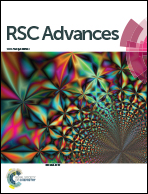Preparation and thermal properties of phase change materials based on paraffin with expanded graphite and carbon foams prepared from sucroses
Abstract
Carbon foam/expanded graphite composite (CEC) was prepared from a sucrose-expandable graphite resin using a thermal foaming method. This CEC was impregnated through its pores with paraffin to obtain a paraffin/carbon foam/expanded graphite composite (PCEC). In the case of CECs, when the amount of added expandable graphite reached 10 wt% to 15 wt%, the microstructure of the CEC was damaged because of the expansion in volume of the expandable graphite. Fourier transform infra-red spectroscopy and X-ray diffraction analysis of PCECs showed that there was no chemical interaction between the paraffin and CECs. With an increase in the amount of expandable graphite in CECs, the adsorption capacity of paraffin and the latent heat first showed an increase and then decreased. The heat transfer capability of the paraffin was truly improved by the CECs. The processes for the preparation of the CECs and PCECs were environmentally friendly, convenient, and inexpensive. The PCECs, with good thermal properties and chemical stabilities, are suitable for low temperature (40–50 °C) thermal energy storage applications.


 Please wait while we load your content...
Please wait while we load your content...